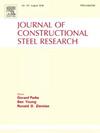Experimental investigation on the cyclic performance of corroded high-strength steel
IF 4
2区 工程技术
Q1 CONSTRUCTION & BUILDING TECHNOLOGY
引用次数: 0
Abstract
In this article, focused on the cyclic performance of corroded high-strength steel, experimental investigation was carried out. Accelerated corrosion tests were conducted with the method of the wet/dry corrosion cyclic tests to simulate the corrosion behaviour of structural steel in an industrial marine atmosphere, then variable strain amplitude cyclic tests were carried out on coupon specimens with a total of 4 corrosion degrees C0/1/2/3 obtained from the accelerated corrosion tests. The cyclic stress-strain curves, skeleton curves, and energy dissipation capacity for each corrosion degree were analyzed. The constitutive model of the corroded Q690D high-strength steel was established and validated with the finite element simulation. The results show that corrosion causes degradation of the specimen loading and unloading stiffness, and deteriorates the bearing capacity under cyclic loads and the energy dissipation capacity. The cyclic stress-strain curves of the simulated results agree well with those of the experimental results, indicating the validity of the established constitutive model of the corroded Q690D high-strength steel. The findings of this study can provide a reference for the cyclic behaviour of corroded high-strength steel and provide basic material data for conducting seismic performance analysis of high-strength steel structures after corrosion.
求助全文
约1分钟内获得全文
求助全文
来源期刊

Journal of Constructional Steel Research
工程技术-工程:土木
CiteScore
7.90
自引率
19.50%
发文量
550
审稿时长
46 days
期刊介绍:
The Journal of Constructional Steel Research provides an international forum for the presentation and discussion of the latest developments in structural steel research and their applications. It is aimed not only at researchers but also at those likely to be most affected by research results, i.e. designers and fabricators. Original papers of a high standard dealing with all aspects of steel research including theoretical and experimental research on elements, assemblages, connection and material properties are considered for publication.
 求助内容:
求助内容: 应助结果提醒方式:
应助结果提醒方式:


